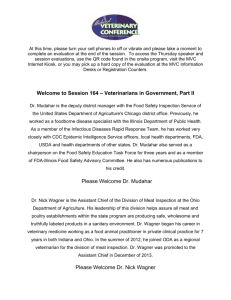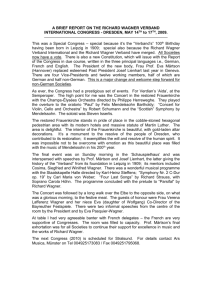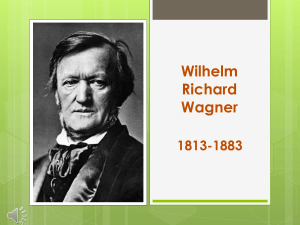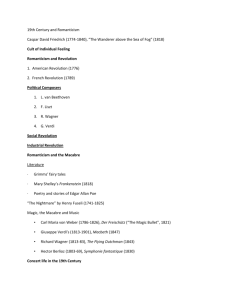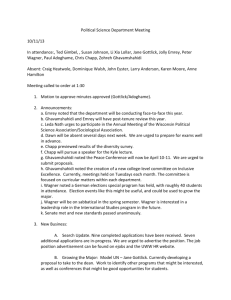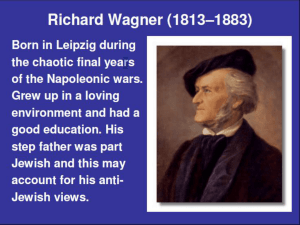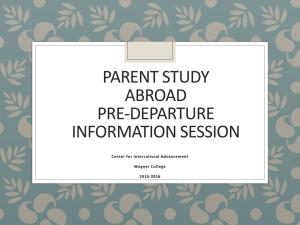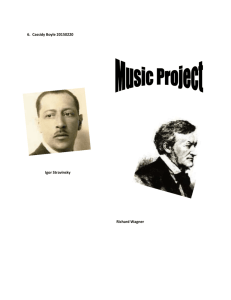Richard Wagner PowerPoint
advertisement
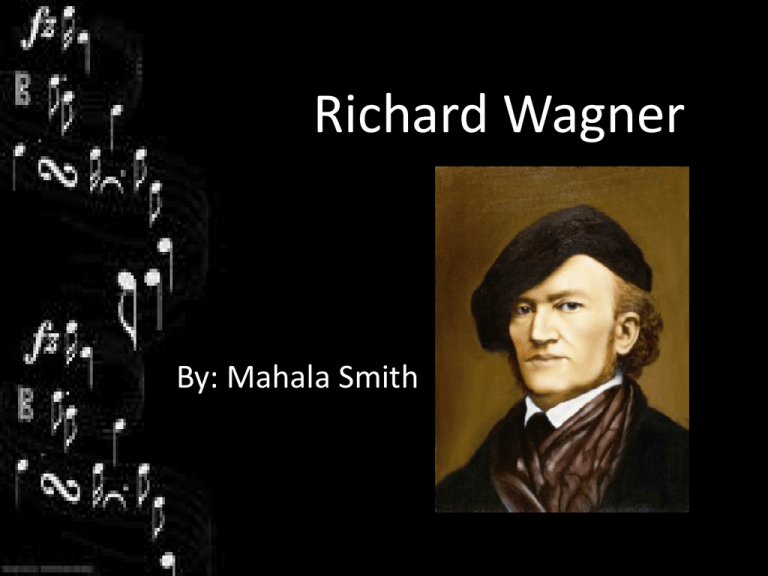
Richard Wagner By: Mahala Smith ichard Wagner and his family moved back to Leipzig in 1827, an in 1828 Beethoven became his inspiration when he heard his 7th and 9th Symphony. Then Wagner wrote a piano transcription of the 9th Symphony. He was also greatly impressed by a performance of the Requiem of Mozart. n 1829, at the age of 16, Richard saw Wilhelmine Schröder-Devrient on stage. She became his ideal of the fusion of drama and music in opera. omposed his first opera, Die Feen (The Fairies) at the age of 20 in 1833. Also, his brother Karl Albert managed to get Richard a position as a choir master in Würzburg. e and his wife Minna had enormous debts in 1839, so they fled to London. On their stormy passage with their Newfoundland dog named Robber, Wagner was inspired to create The Flying Dutchman. fter spending time in Paris, The Wagner’s where headed to Dresden. Wagner lived in Dresden for the next six years, eventually being appointed the Royal Saxon Court Conductor. He staged the first two of his three middleperiod operas in Dresden. They where titled The Flying Dutchman and Tannhäuser ichard was involved in political parties. The German Confederation called for constitutional freedoms and for Germany to become a one nation state. In April 1849, King Frederick Augustus II of Saxony rejected the new constitution. Warrants were issued to arrest the revolutionaries, Richard fled and visited Paris first and then settling in Zürich. uring his exile, Richard Wagner completed Lohengrin, his friend Franz Liszt staged it in his absence. It premiered in Weimar in August 1850. agner was isolated from the German musical world and without any score of income. Before leaving Dresden, he drafted a scenario that would become the four opera cycle Der Ring des Nibelungen. He expanded the story line of his piece Siegfrieds Tod (Siegfried's Death) exploring the hero’s background. lso, in the year of 1850, one of Wagner’s most vulgar pieces, The Jew in Music, viciously attacked the Jewish composers and musicians, mostly in the German society. reatly infatuated with Mathilde Wesendonck, the wife of the silk merchant Otto Wesendonck, inspired Wagner to work on the Ring cycle, and began to work on the love story of Tristan and Isolde. evertheless, while still infatuated with her, he composed the Wesendonck Lieder. ventually the ban on Richard Wagner for the political acts in Germany, where lifted. Der Ring des Nibelungen, unfortunately, was never finished. Also, his financial woes only increased. He had planned on performing Tristan und Isolde, but that dream became impossible and the opera was never preformed. etiring from his life at the age of 80, Richard died of a heart attack. Before his death, he completed Parsifal, and a festival was held for the opening of the opera. He was carried on a gondola over the Grand Canal, and then the body returned and buried in the garden of the Villa Wahnfried. Richard Wagner Museum. Richard Wagner Museum cont. •Villa gifted from Ludwig II of Bavaria. "Here where I found peace delusion, delusion Peace to this house of mine named" engraved. Resources • http://en.wikipedia.org/wiki/Richard_Wagner • http://en.wikipedia.org/wiki/Wilhelmine_Schr%C3%B6der-Devrient • http://www.answers.com/topic/richard-wagner • New Grolier Student Encyclopedia; Deluxe Library Edition • http://www.bayreuth.de/tourismus_kultur_freizeit/tourismus/fests piele/richard_wagner_museum_1025.html
